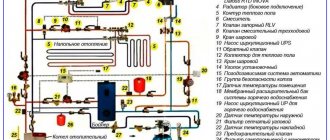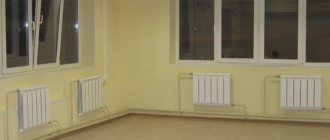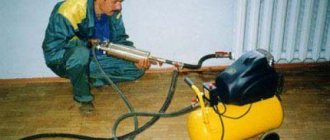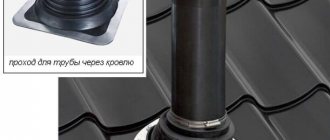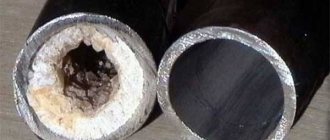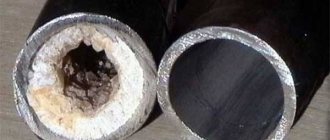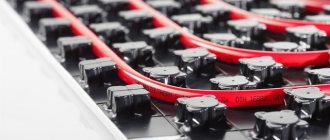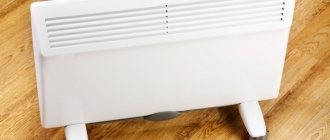Flushing the heating system is a mandatory procedure for high-quality and efficient heating of the house. It is recommended to perform it annually before the hydraulic test. As a last resort, it is necessary to wash it at least once every 2-3 years - this will improve the quality of heating of the premises. We will understand how heating is flushed in order to reduce heating costs and extend the operating time of the entire system as a whole.
You can get rid of scale on pipes even in very advanced cases Source teplo.24bkd.by
Causes of pollution
The main reason is the formation of various debris in the pipeline and directly in the batteries. As a result, the radiators do not work properly and the house does not warm up well.
Often the signal to carry out work is that most of the radiators do not heat well. This is due to several reasons:
- the radiators are filled with air, and it is necessary to bleed air through the Mayevsky taps;
- the system is clogged with dirt.
Determine this so as not to do unnecessary work.
Attention! If the system has been operating for a very long time and consists of a conventional metal pipeline and cast iron batteries, then this prevention is very useful, although there have been cases where even after 10 years of operation, the pipes were not clogged with debris.
There are many reasons for pipe contamination, but they all lead to a decrease in throughput. Source strojdvor.ru
Heat supply and regulation with a two-pipe scheme
This option is more complex, but it allows you to significantly expand the capabilities of the mechanisms for regulating the heat supply to each consumer. The difference between the system is that the coolant that has given up part of the energy does not continue to move through the same pipe to the next consumer; it flows into the second pipe, the “return”. Thanks to this, the coolant has approximately the same temperature along the entire path, at each radiator.
It is this solution that makes it possible to regulate the heat supply in an apartment building using each individual radiator. You can regulate the temperature either manually using a valve or automatically using thermostats.
Regardless of how the heat supply is implemented, the system must include devices for automatic metering and regulation of heat supply in an apartment building. This makes it possible not only to provide housing with the heat necessary for life, but also to significantly save energy resources.
Frequency of cleaning the heating system
Poor heating of the batteries and extraneous sounds during their operation are the most common signals about the need to clean the pipelines. The frequency of this procedure depends on the following factors:
- temperatures during system operation;
- composition of the liquid flowing through the system;
- battery materials;
- pipeline materials.
The first cleaning is carried out immediately after the installation work on the pipeline and radiators. Further, the frequency of flushing the heating system, according to the standards, is as follows:
- for PVC products once a year before starting the boiler;
- for iron products - before and after the operation of pipes and radiators.
The choice of cleaning option depends on the materials used, as well as the overall operating period of the heating devices. Proper flushing of the heating system, regulatory documents and procedure are specified in SNiP 3.05.01-85.
Timely cleaning of pipes will preserve the integrity of individual elements of the system Source ytimg.com
quality - ready for use.
Appendix No_to the Act_
1 As-built and technical documentation - in accordance with the documentation acceptance and transfer certificate.
2 Certificate of acceptance instrumental inspection of repaired property.
3 Certificate of acceptance technical inspection of repaired structures, the technical condition of which before the current repair was determined to be marginal.
4 Appendix on deadlines for eliminating defects and comments.
5 A copy of the minutes of the decision of the general meeting of owners of the premises of an apartment building located at:_
on the issue of approval of the acceptance certificate for work on current repairs of property dated k_»_20_g. No._.
The act is drawn up in four copies of equal force.
Chairman of the commission:
Signature_F.I.O._
Members of the commission:
Signatures_F.I.O._
Stages of mechanical flushing
Directly flushing the heating system in a private house or apartment is a long and labor-intensive procedure:
- The coolant is removed from the system. If this is a house, then there are no problems, but for high-rise buildings you will need access to the basement, which is often closed. Before calling a specialist, you need to take care of this in advance.
- The pipes are disconnected from the radiators. Sometimes you just can’t remove them; you need to heat the coupling with a cutter.
- When the radiator is removed, you need to visually assess its condition, since to speed up the work, mechanical cleaning may first be required.
- The battery is turned upside down and the hole at the bottom is closed. Water is poured into the device right up to the “neck” and drained using the bottom hole. The liquid should flow out, taking with it all the dirt. The process must be repeated until the water comes out clear.
Mechanical flushing is best done outdoors Source gidroguru.com
It is necessary to rotate the radiator because the coolant, moving through it, leaves scale-like growths, and by pouring the liquid in the opposite direction, the surface is cleaned more effectively. If there is a lot of dirt and this option is ineffective, it is necessary to use special acidic agents.
Attention! These acids must not be used for aluminum radiators.
Service organizations
In apartment buildings, the responsibility for maintaining the heating system falls on the shoulders of the management company. The latter has the right:
- carry out all work by its employees;
- attract contractors.
Concluding a contract for system maintenance
To carry out maintenance work on the heating system, a special contract must be concluded. This document contains the following information:
- list of services provided, their individual components and characteristics;
- turnaround time;
- cost of services;
- rights and obligations of the parties;
- liability for violation of the provisions of the agreement.
The agreement can be concluded once or re-signed periodically. This document is a guarantee that the heating system will work efficiently.
Cleaning methods without disassembly
There are methods that can simplify the procedure. Here are several options for flushing the heating system without disassembling it:
- Dispersed cleaning . This method can be used for any materials. Cleaning can be done even with the heating running, and the liquid is drained into a cesspool or sewer in the house;
- Chemical method . In this case, alkalis and solutions are used. This is an excellent and cheap option, but is not applicable for non-ferrous metals;
- Electrohydropulse cleaning . Thanks to an electric discharge, scale is removed from the coolant without deforming the pipeline itself;
Sometimes it is very difficult to unscrew the battery, so it makes sense to choose cleaning methods without disassembly Source ytimg.com
See also: Catalog of companies that specialize in water supply, sewerage and related work
- Pneumohydropulse method . Cleaning is carried out by repeated action of impulses created by special devices;
- Hydropneumatic flushing of the heating system . Scale is removed using thin jets of water supplied under pressure through a special nozzle.
Disperse cleaning
This cleaning resembles a chemical option, but the composition does not come into contact with pipes and batteries, but acts on scale molecularly. Thus, the product almost does not reach the surface of the devices, but only affects the growths, which are crushed and then go into the sewer.
Advantages of the method:
- the high efficiency of this option in contrast to other methods of cleaning the system;
- safety for the external environment, cleaning stations and equipment;
- improvement of the hydraulic performance of the system due to the appearance of a hydrophobic film inside the pipeline, which for a long time protects the surface from the formation of growths;
- does not affect the structure of metal or plastic;
- You can clean equipment made of any material, including aluminum.
Disperse cleaning is not particularly difficult Source samstroy.com
Dry cleaning
This cleaning option involves the use of chemical or biological products.
The flushing method using biological products is more environmentally friendly and effective. It is based on the principle of introducing biological compounds into the system, after which the splitting of the growths begins. This technology does not require disconnecting the batteries or disassembling them.
An undoubted advantage of cleaning with biological agents is that it can be painlessly used in old heating systems; all cleaning products are water-based.
Attention! The required effect will be achieved in 2-3 days.
The chemical cleaning method consists in the action of the product on contamination and its removal by dissolving the growths. These drugs act on scale, which subsequently comes out of the heating pipes simultaneously with the coolant flow.
The most common means are:
- DOCKER TERMO (not for use on non-ferrous metals).
- Metalin (not suitable for aluminum).
- Master Boiler Power (can be used for any materials).
- Compositions "SP" (selected taking into account the instructions on the packaging).
Cleaning batteries requires special equipment Source vodakanazer.ru
The main significant disadvantage of the chemical cleaning method is the difficulty in choosing the right amount of product. The possibility of its use is also complicated by the fact that most often the main parts of the heating system are made of different materials. Chemical compounds have a special effect on both metal and plastic products.
Is this crimping necessary?
Let's start with the basic concepts. What is a home heating system? Unless you have electrical panels, then most likely this is a line of pipes with coolant circulating through them. In order for it to move within the system, by default the coolant must be in a liquid state. And liquid, as you know, always strives to find a way out of a confined space. If circulation is disrupted for some reason, the entire system stops working.
PHOTO: pp.userapi.com High-quality heating is the result of constant monitoring of the integrity of the entire system
PHOTO: kliningovyj-raj.ruAnd if the tightness of the main line is broken, then, in addition to the lack of heat, you may also be faced with the need for emergency repairs to your apartment and even your neighbors’
There is only one simple way to check for possible disturbances in the operation of the main line - increase the pressure in the system so that connection defects are detected, which should be paid attention to before starting the heating. Thus, pressure testing is an actual pressure test of the heating main before the operating season
To check the system for leaks, the pressure should be increased by 20-80%. The percentage of pressure increase depends on the equipment installed in the line. After all faults are detected during pressure testing, the necessary repairs are made and the tightness of the system is restored.
PHOTO: zamena-radiatora.ru All this takes time, so do not postpone the procedure until the last days before the start of the heating season
Video description
Flushing batteries hydropneumatically is shown in detail in this video:
Hydrodynamic method
The essence of this washing is the active action of water on the growths. When the required section of the pipeline is selected, a stream of pressurized water is directed at it. The liquid comes out of a special nozzle of the required cross-section.
When deciding how to flush the heating system in a private house, consisting of cast iron elements, it is recommended to choose the hydrodynamic option. It is quite difficult to remove deposits from this metal using chemicals.
One of the main advantages of the cleaning method is environmental friendliness. This is due to the fact that only water is involved in the process, and not alkalis and acidic preparations. To achieve the required result, special equipment is used that allows you to create a pressure of more than 250 atm.
Using a special product, the layer to be removed is softened. And only then the surfaces of the system begin to be processed.
The operating principle of hydrodynamic cleaning Source tildacdn.com
During the work, a pneumatic gun is used, which efficiently cleans radiators and a pipeline about 50 meters long. The equipment can only be used with pipe diameters of no more than 15 cm. The device is small in size and quite easy to use.
The main advantage of a pneumatic gun is that it successfully performs spot cleaning of all elements and allows you to touch the most inaccessible areas. During hydropneumatic cleaning, it is not necessary to disconnect heating devices from the system, which is also important.
What and how to flush heating radiators
Let's talk about dry cleaning. You can use different means. From the experience of “users” there are the following options:
- pour in whey for a day, turn occasionally;
- pour a pack of regular soda, pour boiling water, several treatments help with most precipitation;
- the same, but with caustic soda - it works better;
- pour a solution for cleaning a car radiator, add boiling water, drain after a few hours;
There is one point in all these methods: it can corrode the gaskets. Then you will have to disassemble everything into sections, change the gaskets and put everything back in place. So many people advise rinsing thoroughly with water, or, in extreme cases, with air - using a car compressor.
Briefly about the main thing
To maintain the efficiency of heating quality, a number of rules must be followed:
- Avoid using unprepared liquid as a coolant. In its simplest form, preparation involves boiling. This way the amount of salts is significantly reduced. But it is more effective to purchase specially created inhibitors that reduce the activity of corrosive processes. When choosing them, you need to make sure that the composition and material of the surfaces match.
- Know when heating systems are flushed and strictly follow the main steps.
- Coarse filters must be installed on heating lines. They are mounted in such a way that the pipe faces down. This will make it easier to clean, since all dirt is drained simultaneously with water.
- When choosing a contractor company, pay attention to companies that provide a guarantee for the activities carried out.
The heating system is cleaned by the company's professional staff within one day. Therefore, you should not neglect this service. The result will be a constant comfortable temperature in all rooms, as well as significant savings on heating.
Why and when to carry out hydraulic tests
Hydraulic testing is a type of non-destructive testing that is carried out to check the strength and tightness of pipeline systems. All operating equipment is subjected to it at different stages of operation.
In general, three cases can be identified in which tests must be carried out without fail:
regardless of the purpose of the pipeline:
- after completion of the production process for the production of equipment or parts of the pipeline system;
- after completion of pipeline installation work;
- during operation of the equipment.
Hydraulic testing is an important procedure that confirms or refutes the reliability of the operating pressure system. This is necessary to prevent accidents on highways and preserve the health of citizens.
The procedure for hydraulic testing of pipelines in extreme conditions is being carried out. The pressure under which it passes is called the test pressure. It exceeds the usual operating pressure by 1.25-1.5 times.
Features of hydraulic tests
Test pressure is supplied to the pipeline system smoothly and slowly, so as not to provoke water hammer and accidents. The pressure value is determined not by eye, but by a special formula, but in practice, as a rule, it is 25% more than the working pressure.
The water supply force is controlled on pressure gauges and measurement channels. According to SNiP, jumps in indicators are allowed, since it is possible to quickly measure the temperature of the liquid in a pipeline vessel. When filling it, be sure to monitor the accumulation of gas in different parts of the system.
This possibility should be excluded at the initial stage.
After filling the pipeline, the so-called holding time begins - a period during which the equipment under test is under increased pressure.
It is important to ensure that it is at the same level during exposure. After its completion, the pressure is minimized to operating condition. Personnel operating it must wait in a safe place, as testing the system's functionality may be explosive.
After the process is completed, the results obtained are assessed in accordance with SNiP. The pipeline is inspected for metal explosions, deformations
Personnel operating it must wait in a safe place, as testing the system's functionality can be explosive. After the process is completed, the results obtained are assessed in accordance with SNiP. The pipeline is inspected for metal explosions and deformations.
